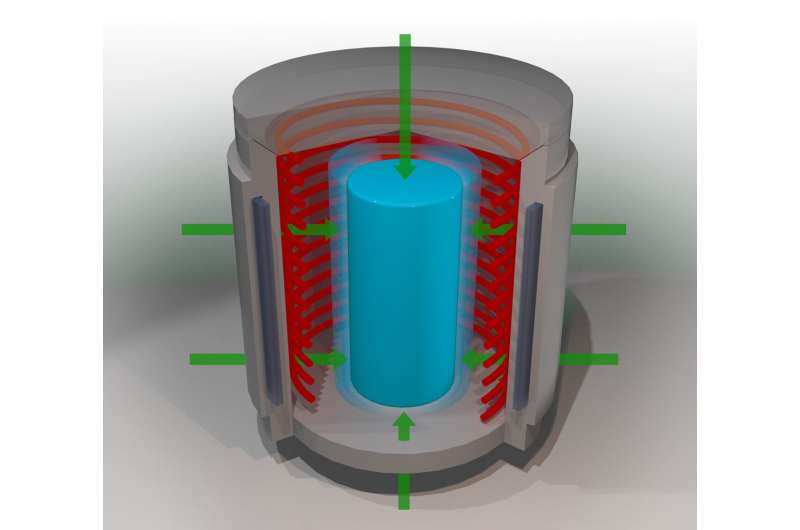
Following months of promising test results, battery researchers at the Department of Energy’s Oak Ridge National Laboratory are recommending that the solid-state battery industry focus on a technique known as isostatic pressing as it looks to commercialize next-generation batteries.
Commercial-scale production of solid-state batteries is a goal for electric vehicle manufacturers because these batteries have the potential to charge faster, last longer and operate more safely than the lithium-ion batteries currently on the market.
In a focus review paper for ACS Energy Letters, ORNL researchers recommend attention be given to the little-studied isostatic pressing approach. This process uses fluids and gases like water, oil or argon inside a machine to apply consistent pressure across a battery component, creating a highly uniform material. With the help of an industry partner that produces this pressing equipment, ORNL researchers found that isostatic pressing could make battery production easier and faster while creating better conditions for energy flow.
When a battery charges or discharges, ions move through an electrolyte between its positive and negative poles, which are made of thin layers of metal. In the lithium-ion batteries that power everything from cell phones to electric vehicles, the electrolyte is a liquid through which ions travel easily. Unfortunately, this liquid can also spill or ignite if the separation between battery layers is compromised.
ORNL’s Marm Dixit and colleagues found that isostatic pressing can create thin layers of solid, uniform electrolyte, maintaining a high level of contact between the layers for smooth ion movement. The method works with a variety of battery compositions at different temperatures and pressures.
Among the promising results, isostatic pressing was found to be extremely successful at low temperatures and with soft electrolyte materials, which are easier to process and which have favorable crystal structures for ion movement. Previously isostatic pressing of batteries had been done mostly at extremes: very high temperatures or at room temperature, but not in between.
“All these materials have their unique advantages that researchers would like to exploit,” Dixit said. “That’s why it’s important that you can do isostatic pressing at anywhere from room temperature to several thousand degrees Fahrenheit: It means you can use anything from polymers to oxides, the whole range of materials.”
This versatility is key to a consistent manufacturing process for the broad variety of solid-state battery designs and materials being developed, Dixit said. Isostatic pressing would also be relatively easy to scale up commercially—a finding that has garnered significant attention as companies race to supply solid-state batteries to car manufacturers. Several leading auto companies have announced their intention to sell electric vehicles that run on solid-state batteries within a few years.
Ilias Belharouak, a corporate fellow at ORNL and head of its electrification section, said solid-state battery technology needs to be perfected for large-scale manufacturing. “Make no mistake, all solid-state batteries are on a journey for the long haul,” he said. “But the isostatic pressing technology, if scalable, would provide a way to assemble the battery layers without impractical external pressures.”
Isostatic pressing has been used for decades in fusion bonding and joining materials. Recently, it has been a tool for eliminating voids and anomalies in 3D-printed parts. However, its testing for battery applications has been limited.
ORNL researchers indicated isostatic pressing may also allow manufacturing the three battery layers as a single, dense system rather than creating them separately before joining them.
In the ACS Energy Letters paper, Dixit’s team stressed the importance of pursuing a solid-state battery that can be scaled up for manufacturing. “Effectively addressing this challenge would leapfrog present-day battery technology into the next decades by enabling energy-dense solid-state batteries to meet the burgeoning demands of portable electronics, grid storage, electric vehicles and even (aviation) applications,” they wrote.
ORNL researchers are continuing to conduct tests to learn which pressing temperature and pressure combinations work best with different materials, and how those factors affect texture. “Isostatic pressing can alter texture—the question is whether it can actively control it,” Dixit said. “The ability to manipulate crystal texture would have significant benefits for solid-state batteries.”
More information:
Marm Dixit et al, The Role of Isostatic Pressing in Large-Scale Production of Solid-State Batteries, ACS Energy Letters (2022). DOI: 10.1021/acsenergylett.2c01936
Citation:
Research team supports isostatic pressing for solid-state battery manufacturing (2023, March 23)
retrieved 23 March 2023
from https://techxplore.com/news/2023-03-team-isostatic-solid-state-battery.html
This document is subject to copyright. Apart from any fair dealing for the purpose of private study or research, no
part may be reproduced without the written permission. The content is provided for information purposes only.
For all the latest Technology News Click Here
For the latest news and updates, follow us on Google News.
